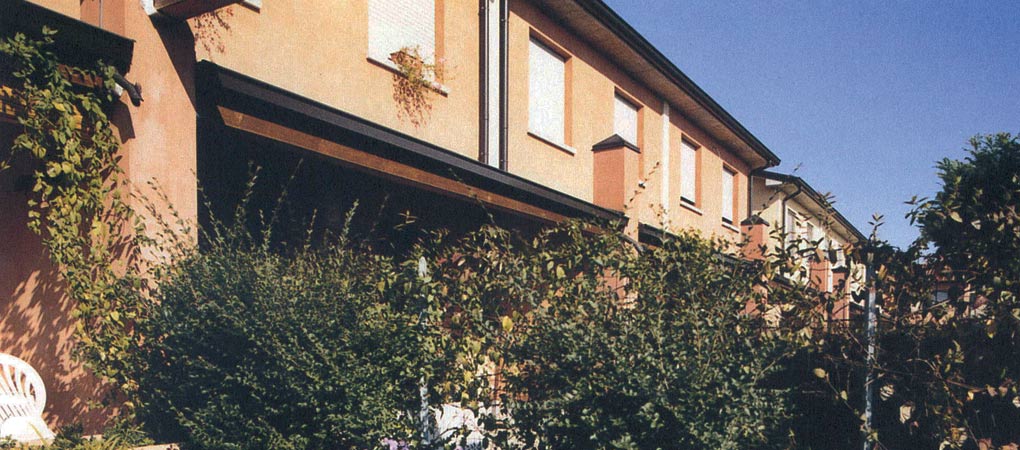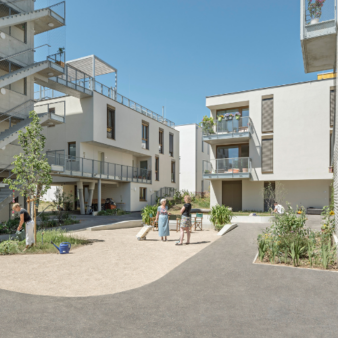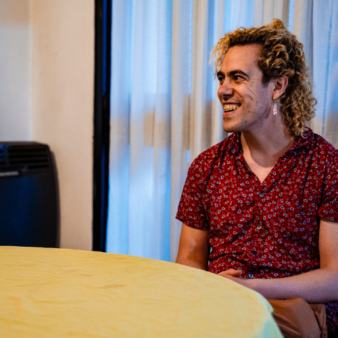The First-time Homes for Young Couples project was developed by the Andria Housing Cooperative to meet the needs of young people, for whom there was little affordable or suitable housing on the market. Arranged in small two-storey terraces, a simplified low-cost internal design is used to provide expandable accommodation. The first floor is left uncompleted but can be later converted to form bedrooms and bathrooms as needed. Social cohesion is fostered as households do not have to move house in order to meet their changing accommodation needs.
Project Description
Aims and Objectives
- To respond to the living needs of young couples through an original project taking inspiration from their situation and expectations.
- To provide state of the art, low-cost single family dwellings for young people which can be partly self-built.
The project is located in northern Italy in the region of Emilia Romagna. It is situated in an industrialised plain with low rates of unemployment and subject to high immigration by families from southern Italy and overseas. In recent years rises in costs of land and building materials and a diminution in buying power of families have led to severe problems in the housing market.
Liberalisation of rent policies has caused an enormous rise in rents and house prices have also rocketed. Young couples who have not worked long enough to build up savings are in great difficulty as regards to getting a place to live. Rent for a small, impoverished apartment in a large block eats up all their resources. The rental of a small flat ranges from $400 – 600 per month.
Co-operative Andria viewed the problem starting from young people’s needs and subsequently proposed a new and original solution. The idea was to build a low-cost single family home which was partially completed to enable young couples to have a home fit for later evolution.
In order to keep the cost down the basic habitable house was provided by the builders and the rest was carried out by the buyer. A typical house consists of a low-roofed units including garage and cellar, a glass-covered space between house and services and in the main part of the house a big living room, a kitchen, a cupboard and a bathroom. At the back of the house there is a private garden. The completed projects are on nine different sites in the region, ranging in size from 8 to 34 houses.
The project was developed by Andria’s Design and Research Office on the basis of meetings with young couples and with their expressed needs in mind. The couples were invited to use the Ministry of Public Work’s experimental home laboratory so that they could view their future homes in full scale and work out their needs for finishing and furnishing. Consultation was maintained with young couples throughout the project’s development. The municipal administration supported the initiative for provision of such accommodation and made low-cost land available for the project.
The average cost of houses varies between the different projects from $80,000 to $129,000. Typically the member’s deposit meets 45 per cent of the cost with the remainder coming from a bank mortgage. The young couples are the co-operative owners of the properties and meet all the costs involved in extending and adapting the properties. Co-operative Andria has negotiated special mortgage rates with the banks and is able to provide young couples with advice in their mortgage applications and financial decisions regarding their home. Restrictions on the selling price are related to the rate of inflation and the length of time the household has lived in the property. Authorisation has to be obtained from the municipality if a family wishes to sell one of these dwellings.
Why is it innovative?
- Methodology in involving the young people throughout the project
- Opportunity to extend the house in accordance with family means and needs
- Use of self-finishing as a means of keeping the cost down
- Opportunity to have an interesting as well as an affordable house (based on the design principle of the hay-loft).
What is the environmental impact?
The project utilised previously degraded and neglected districts to build the houses which in return has revitalised these areas. The houses were built using local materials and technology including natural gas heating systems. The self-finishing aspect of the project simplified the building process, saving resources and energy.
Is it financially sustainable?
The houses are designed to the utmost simplification and cost minimisation with average cost being 10 per cent less than other houses. The cheaper location of the houses, the agreements with banks to give easy terms (3.9 per cent) to young couples in this programme and the capacity of the house to be extended also enables the families to reduce and spread the costs.
What is the social impact?
The basic ‘evolutionary’ design of the homes allows the young couples to settle in a community on long-term basis when their family needs expand. The resulting sense of belonging means that they can contribute to the social life of the district and the community. Working together on the design of their homes also brings the group of young families into close contact which helps to establish close community ties. The vitality and enthusiasm of the young people has often given established districts a new lease of life and new energies for the social and community life.
Partnership
NGO, local government



